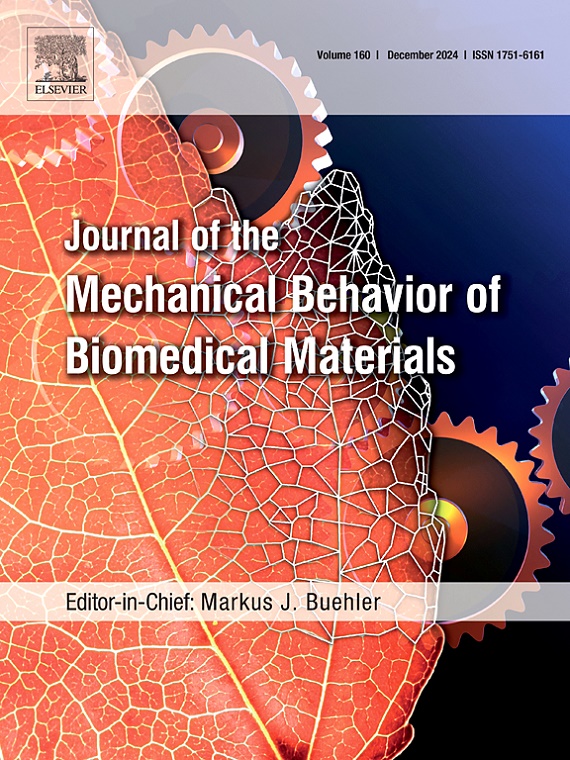How robust is the virtual fields method with respect to experimental inhomogeneities for bulge inflation testing of hyperelastic materials?
IF 3.3
2区 医学
Q2 ENGINEERING, BIOMEDICAL
Journal of the Mechanical Behavior of Biomedical Materials
Pub Date : 2025-03-13
DOI:10.1016/j.jmbbm.2025.106965
引用次数: 0
Abstract
Mechanical characterization of biological soft tissue can be a challenging process due to its inherent inhomogeneities. Constitutive model calibration based on the virtual fields method enables the use of full-field deformation and thickness data in order to obtain region-specific material parameters. However, for practical reasons, assumptions are often made in model calibration frameworks, e.g., by using the average sample thickness and deriving homogenized material parameters.
This study investigates the effect of these assumptions on the material parameters predicted by the virtual fields method. To this end, synthetic datasets of bulge inflation experiments were created using a finite element model and parameter identification was performed.
The ground truth parameters could be retrieved for a homogeneous sample with a high accuracy of 0.15%, even when only part of the full-field deformation data was known. For samples with a nonuniform thickness, the parameters could still be obtained with an error of 4% when taking into account the average sample thickness. However by including the region-specific thickness, parameters and stress responses closer to the ground truth were found, within 1% error. When samples showed inhomogeneous material properties spread throughout the sample, the obtained parameters resulted in a more homogenized stress response, eliminating the minimal and maximal stresses of the ground truth response. The ground truth stress response could not be obtained when the sample consisted of regions of different material properties. Further, only an incremental error of was seen when decreasing the resolution in the parameter fitting framework by a factor 2.5 for both homogeneous samples and samples with a nonuniform thickness.
These results highlight the robustness of the virtual fields method and can be translated to other test types.

关于超弹性材料膨胀试验的实验不均匀性,虚拟场方法的鲁棒性如何?
由于其固有的不均匀性,生物软组织的力学表征可能是一个具有挑战性的过程。基于虚拟场方法的本构模型标定可以利用全场变形和厚度数据来获得区域特定的材料参数。然而,由于实际原因,通常在模型校准框架中做出假设,例如,通过使用平均样品厚度和推导均质材料参数。本文研究了这些假设对虚场法预测材料参数的影响。为此,利用有限元模型建立了膨胀实验的合成数据集,并进行了参数辨识。对于均匀样品,即使只知道部分全场变形数据,也可以以0.15%的高精度检索地面真值参数。对于厚度不均匀的样品,在考虑样品平均厚度的情况下,仍然可以得到误差为4%的参数。然而,通过包括区域特定厚度,参数和应力响应更接近地面真实,误差在1%以内。当样品表现出非均匀的材料特性时,所获得的参数导致应力响应更加均匀,消除了地面真值响应的最小和最大应力。当样品由不同材料性质的区域组成时,无法获得真实应力响应。此外,只有0.6%pt的增量误差。在参数拟合框架中,均匀样品和非均匀厚度样品的分辨率都降低了2.5倍。这些结果突出了虚拟场方法的鲁棒性,可以转化为其他测试类型。
本文章由计算机程序翻译,如有差异,请以英文原文为准。
求助全文
约1分钟内获得全文
求助全文
来源期刊

Journal of the Mechanical Behavior of Biomedical Materials
工程技术-材料科学:生物材料
CiteScore
7.20
自引率
7.70%
发文量
505
审稿时长
46 days
期刊介绍:
The Journal of the Mechanical Behavior of Biomedical Materials is concerned with the mechanical deformation, damage and failure under applied forces, of biological material (at the tissue, cellular and molecular levels) and of biomaterials, i.e. those materials which are designed to mimic or replace biological materials.
The primary focus of the journal is the synthesis of materials science, biology, and medical and dental science. Reports of fundamental scientific investigations are welcome, as are articles concerned with the practical application of materials in medical devices. Both experimental and theoretical work is of interest; theoretical papers will normally include comparison of predictions with experimental data, though we recognize that this may not always be appropriate. The journal also publishes technical notes concerned with emerging experimental or theoretical techniques, letters to the editor and, by invitation, review articles and papers describing existing techniques for the benefit of an interdisciplinary readership.
 求助内容:
求助内容: 应助结果提醒方式:
应助结果提醒方式:


